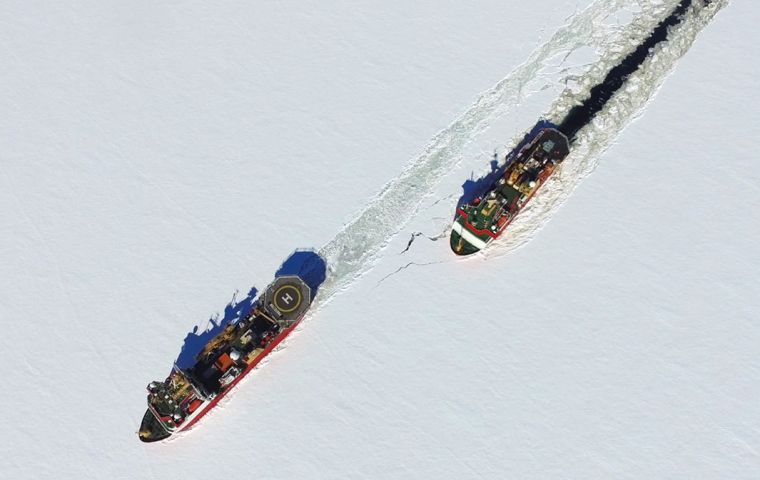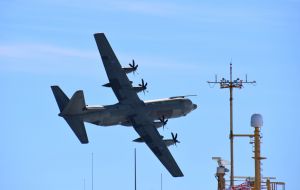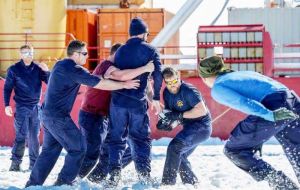MercoPress. South Atlantic News Agency
HMS Protector and RRS Shackleton support 100 scientists researching Antarctica glacier
 Working together with British Antarctic Survey’s vessel RRS Ernest Shackleton, the Plymouth-based ice-strengthened vessel crunched her way to a remote Antarctic ice shelf
Working together with British Antarctic Survey’s vessel RRS Ernest Shackleton, the Plymouth-based ice-strengthened vessel crunched her way to a remote Antarctic ice shelf  British Antarctic Survey aircraft doing routine patrols near the Thwaites Glacier, Antarctica.
British Antarctic Survey aircraft doing routine patrols near the Thwaites Glacier, Antarctica.  Members of HMS Protector's Ship's Company enjoying a game of Rugby on The Strange Ice Shelf in Antarctica.
Members of HMS Protector's Ship's Company enjoying a game of Rugby on The Strange Ice Shelf in Antarctica. Royal Navy survey ship HMS Protector smashed through nearly 300 miles of Antarctic ice to help scientists begin a five-year mission to understand how West Antarctica is contributing to global sea-level rise.
Working together with British Antarctic Survey’s vessel RRS Ernest Shackleton, the Plymouth-based ice-strengthened vessel crunched her way to a remote Antarctic ice shelf to support a team of around 100 scientists who seek to understand a glacier the size of Great Britain.
The gigantic Thwaites Glacier is melting – accounting for four per cent of the annual sea level rise every year. Scientists fear the huge mass of ice could eventually collapse, raising the global sea level 80 centimeters – more than two and a half feet – and so are beginning a five-year program of field activities on the glacier.
With the nearest British and American scientific research stations more than 1,600 kilometers away from the research site, the two ships were called upon to deliver essential heavy stores to the ice edge in preparation for the arrival of the scientists next year.
The two vessels delivered four large tracked vehicles, 14 snow mobiles, numerous sledges, a caboose to act as living quarters, fuel and food to last nearly 5,000 days.
Upon arriving at the Stange Ice Shelf, a team went on to the ice to dig deep holes to secure the ship’s berthing lines. The crew of HMS Protector then worked around the clock for 72 hours with their colleagues from the British Antarctic Survey to offload around 300 tons of equipment, machinery and supplies as quickly as possible.
“It was hard work yet extremely rewarding; having the opportunity to play a small part in such a huge project is something that I will certainly look back on with pride later in my life,” said Leading Engineering Technician Colin ‘Chappers’ Chapman, part of the team involved in the unloading.
The sailors and Royal Marines took a short break from the lifting and shifting to play rugby, a match organised by HMS Protector’s physical training instructor, David Clayton-Charlesworth.
“How many people in their life will get the opportunity to play rugby in Antarctica? It is something that just had to be done and was enjoyed by all that took part and watched,” he said.
Joining in the long-range Antarctic mission have been BAS Twin Otter aircraft and an RAF Hercules, which dropped 70 tons of supplies to outlying UK research sites and conducted a low fly-past of Protector while she was berthed at the ice shelf – rounding off a memorable three days at the foot of the world.
“It’s been a privilege for HMS Protector to contribute to the International Thwaites Glacier Collaboration and a thrill for the ship’s company to see first-hand how this globally significant research is being supported,” said HMS Protector’s Commander, Commander Peter Higgins.
BAS Director of Science, Professor David Vaughan, added: “Without the assistance of HMS Protector, we just couldn’t have delivered all the necessary cargo to this remote part of West Antarctica in time to begin this vital research program, which will help us predict future global sea-level rise.
“This partnership with the Royal Navy has been enormously valuable and the kit they have delivered will mean that our joint UK/US science teams can begin their fieldwork on schedule next year.”
HMS Protector has been away from its home port since September 2015 and will not return home until May next year. She spends summer in the Southern Hemisphere conducting research on the fringes of the frozen continent and austral winters in milder waters off West and East Africa. (Credit Pic & video HMS Protector)




Top Comments
Disclaimer & comment rules-

Read all commentsLOL ... by contributing to sea level rise.
Jan 23rd, 2019 - 02:55 pm 0Commenting for this story is now closed.
If you have a Facebook account, become a fan and comment on our Facebook Page!